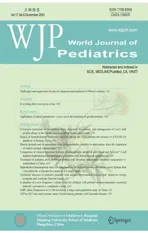Evaluation of a new frequency-volume chart for children with primary monosymptomatic nocturnal enuresis: a prospective, comparative study
2022-01-12JingWangDongJieWangHaiDongFuDeXuanWangQingaYngXiaoJiePengRuiFuHuanDanaYngRuiFengZhangXiaoWenWangJiangWeiLuanFeiZhaoQiuXiaChenFangFangLiangLuCaoJianJiangZhangYingJieLiYangDong0HuiMeiHuangYingBaoXiaoYuS
Jing Wang · Dong-Jie Wang · Hai-Dong Fu · De-Xuan Wang · Qing aYng · Xiao-Jie Peng · Rui Fu ·Huan-Dan aYng · Rui-Feng Zhang · Xiao-Wen Wang · Jiang-Wei Luan · Fei Zhao · Qiu-Xia Chen ·Fang-Fang Liang · Lu Cao · Jian-Jiang Zhang · Ying-Jie Li · Yang Dong0 · Hui-Mei Huang · Ying Bao ·Xiao-Yu Shen · Wei Zhou · Guang-Hai Cao · Cui-Hua Liu · Yan-Yan Jin · Mei-Lin Ma · Li Jiang · Qian Shen ·Hong Xu · Jian-Hua Mao
Abstract
Keywords Children · Compliance · Nocturnal enuresis · Voiding diary
Introduction
The clinical guidelines for initial management of all the enuretic children recommend using a standardized questionnaire and voiding diary to assess bladder function and urine production during both day and night [ 1]. The voiding diary is one of the simplest, most objective, and noninvasive tests available to prospectively evaluate the output of diurnal and nocturnal urine, voiding frequency, maximum voided volume, and the bladder capacity together [ 2]. Therefore, the voiding diary is highly useful as it can calculate the urine volume for the entire day and night and can identify different subtypes of primary monosymptomatic nocturnal enuresis (PMNE), which allows further fine-tuning of treatment according to the children’s characteristics and the family’s motivation.
The widely used voiding diary recommended by the ICCS should contain 4 days of daytime dairy and 7 consecutive days of bedwetting diary [ 3]. This type of diary is both difficult and tedious to complete for some parents and children[ 4]. The current consensus on using FVCs of > 2 days seems to be the most defensible policy, but more research of high quality is required, especially into the relationship of FVC duration with compliance [ 5].
In this present study, we designed a new modified 3-day weekend frequency-volume chart (FVC). The main purpose of the study was to compare the user’s compliance when using these two different voiding diaries and to verify the validity of the newly designed FVC. Our hypothesis was that the modified FVC could be applied to obtain the voiding characteristics of children with PMNE similar with ICCSrecommended voiding diary.
Methods
Study design
Based on the ICCS-recommended voiding diary, a new modified 3-day weekend FVC was designed in the present study to include 2 consecutive daytime recordings and 3 consecutive nighttime recordings made during a weekend,which begins on Friday evening and ends on Sunday evening (Supplemental Fig. S1). In this prospective comparative clinical study, we compared the compliance and validity of our modified diary versus the ICCS-recommended voiding diary (Supplementary Fig. S2). The study was conducted following the Declaration of Helsinki. Ethical approval was obtained from the research ethics committees of all participating hospitals. All patients provided informed consents.
Participants
In this study, patients were recruited from 13 centers across China from September 1, 2017 to January 30, 2019. The inclusion criteria were as follows: aged 5-18 years with a minimum wetting frequency of once per month and previously untreated. Patients with the following conditions were excluded: daytime voiding dysfunction, neurological or anatomical abnormalities or infection of the urinary tract, neuropsychiatric disorders, and secondary nocturnal enuresis.
Randomization and masking
After completing a questionnaire, each patient was required to take a brief but thorough physical examination, urine dipstick testing, estimation of glomerular filtration rate, renal/bladder ultrasound and measurement of post-void residual.Eligible patients were then randomly assigned in a 1:1 ratio to record either the ICCS-recommended voiding diary or the modified FVC. Patients were randomized using a computergenerated random number list. All of the parents/guardians were instructed on how to properly complete a voiding diary.
Procedures
Participants reported the time that they went to bed in the evening and then woke up in the morning, which allowed for classification of daytime and nighttime events. The volume of every void was measured in a measuring cup provided by the present study, and the time and volume of the measurements were recorded.
Based on the output of diurnal and nocturnal urine,maximum voided volume ( MVV) reported in the diaries,patients were classified into four subtypes. Estimated bladder capacity (EBC) was calculated as [30 + (age in years × 30)] mL [ 3]. Nocturnal polyuria (NP) was assigned if the total nocturnal voided volume (TVV) was 1.30 times more than the estimated bladder capacity. The smaller bladder subtype was assigned if the daytime maximum bladder volume (MVV) was less than 0.65 times to the estimated bladder capacity. If both conditions were met, the patient was assigned to be a mixed subtype. If neither of the conditions was met, the patient was assigned to be a “normal”subtype [ 6]. Patients with nocturnal polyuria, mixed subtype, or “normal” subtype were administered with desmopressin. For the response of desmopressin, non-response is defined as a decrease by 0% to 49%, partial response is defined as a decrease by 50-89%, response is defined as a decrease by 90% or greater and full response is defined as a decrease of 100% or less than one symptom occurrence monthly [ 7].
Outcomes
The primary outcome measures were compliance. To evaluate the compliance of the modified FVC for diagnosing children with PMNE, the modified FVC was compared with the ICCS-recommended voiding diary using the following criteria: the completing index (CI) and the quality score (QS).The completing index is defined as the measurement of the actual number of days completed divided by the number of days required to complete. And it is divided into four groups including low (0 ≤ CI ≤ 0.25), medium (0.25 < CI ≤ 0.5),good (0.5 < CI ≤ 0.75), and high (0.75 < CI ≤ 1). The quality score of FVC was defined as follows: if the diaries included more than 80% of the events (for both time and volume;for example, patients that were 80% compliant were those with at least 80% completeness for time recordings as well as for volume recordings), the quality score was assigned a value of “Good”. If the diaries included 60-80% of the events, the quality score was assigned a value of “Medium”.If the diaries included 40-60% of the events, the quality score was assigned a value of “Poor”. Diaries that failed to include more than 40% of the events were assigned a value of “unusable”.
The secondary outcome measures were the validity. To assess the validity of the present modified FVC, it was compared with the ICCS-recommended voiding diary using the following criteria: the constituent ratio of subtype, micturition parameters and the response rate of desmopressin on patients with NP, mixed and “normal” subtypes.
Sample size estimation
The sample size was calculated using the maximum value needed to achieve a sensitivity of 0.8 or a specificity of 0.7.We enrolled 20% more patients than the required sample size to compensate for possible losses. Thus, we considered the minimum required sample size to be 776 persons.
Statistical analysis
The measurement data were expressed by the mean value ± standard deviation, and the enumeration data were expressed as percentage or rate. Two-sampledttests were used for continuous variables. Chi-squared tests were used to compare the difference of CI (high vs all others), QS (good vs all others), and other categorical variables. A test with aPvalue less than 0.05 was judged as revealing a statistically significant difference. Data analysis was performed using SPSS version 24.
Results
A total of 1200 participants admitted from September 1,2017 to January 30, 2019 to 13 clinical centers were enrolled in this prospective study and were randomly assigned to one of the two diary groups in a 1:1 ratio (Fig. 1). The demographics and clinical characteristics of the patients in the two groups are summarized in Table 1. There were no significant differences in terms of baseline demographics or clinical presentation between the two groups.
Among the participants, 1023 (85.3%) returned a baseline bladder diary (503 (83.8%) from the ICCS voiding diary group versus 520 (86.7%) from the modified FVC group (P= 0.166, Table 2). If a diary was identified as unusable, it was excluded from analysis. A total of 916 participants returned a usable voiding diary, which included 447 with ICCS voiding diary and 469 with the modified FVC(P= 0.489, Table 2).
Compliance between ICCS voiding diary and modified FVC
Both the daytime and nighttime completing index (CI) of the modified FVC were better than those of the ICCS voiding diary (P< 0.001 for daytime,P= 0.002 for Nighttime,Table 2). For categorized daytime and nighttime completing index, a significantly higher percentage of dairies got a“high” CI in modified FVC group (P< 0.001 for daytime,P= 0.011 for nighttime). No significant differences of nighttime QS were found between two groups (P= 0.443). However, there was a significantly higher proportion of diaries in the modified FVC group that received a “good” daytime QS than in the ICCS voiding diary group (P< 0.001, Fig. 2).
Validity between ICCS voiding diary and modified FVC
Table 3 summarizes the results of the constituent ratio of subtypes between the ICCS voiding diary group and the modified FVC group. No significant difference was found between the two groups (P= 0.351).
Furthermore, there were no significant differences for the micturition parameters in patients with nocturnal polyuria subtype, except for the items “Nocturnal micturition frequency” and “Average voided volume/EBC” at night. These differences did not affect the validity of the modified FVC in different subtype classifications because no significant difference was found between the two groups in “Total voided volume/EBC” during night (Table 4).
Among patients with small bladder subtype, no significant differences were found between the two groups in diurnal micturition frequency, average voided volume/EBC, total voided volume/EBC, maximum voided volume/EBC, nocturnal total voided volume/EBC, or nocturnal average voided volume/EBC. However, there was a significant difference in the nocturnal micturition frequency (Table 5). There was no significant difference between the two groups in the response rate to desmopressin in children with nocturnal polyuria,mixed and normal subtypes (P= 0.095, Fig. 3).
Discussion
In this study, we designed a new modified 3-Day Weekend FVC and evaluated the compliance and validity of this modified FVC for patients with PMNE from 13 centers in China.We confirmed that this diary could reasonably be applied to get the condition of children with PMNE.
PMNE is defined as intermittent incontinence of urine in a sleeping child over 5 years of age who has previously been dry for less than 6 months in the absence of congenital or acquired defects of the urological or central nervous system and without daytime voiding symptoms [ 8]. Therefore,PMNE is a special type of urine incontinence. Both PMNE and urinary incontinence have secondary stressful results for the children and their parents or caretakers, such as feelings of embarrassment, shame, guilt, and loss of self-esteem [ 8,9]. Therefore, timely and appropriate management is needed to avoid detriment to the well-being of those affected. The clinical guidelines recommend taking a proper history and recording a voiding diary (VD) for primary evaluation of the patients with PMNE because the bladder capacity and the volume of nocturnal urine are vital parameters for distinguishing different subtypes in MNE [ 1].

Fig. 1 Flow chart of study populations, including the number of patients who were assessed for eligibility, underwent randomization and returned the usable diaries. Of 1200 participants assessed for eligibility and were randomly enrolled in ICCS voiding diary group ( n = 600) or modified frequency-volume chart (FVC) group( n = 600), 916 patients (447 in the ICCS voiding diary group and 469 in the modified FVC group) returned the usable diaries.
Although clinically helpful, VD is often viewed as burdensome to patients and their guardians [ 10, 11]. We demonstrated that 78.2% (469 in 600 cases) of the participants were able to complete the new modified FVC appropriately,which is similar to the completing rate of the ICCS voiding diary (74.5%). The completing rates in this study were similar with other studies [ 12, 13].
To further validate the user compliance of this new modified FVC, it was compared with the ICCS diaries by diurnal and nocturnal CI, categorized diurnal CI and QS and categorized nocturnal CI and QS together in this prospective study. The results showed that significant differences between the two groups were found in diurnal CI and QS and diurnal QS. There were no significant differences in the nocturnal QS between groups.The discrepancy between diurnal and nocturnal compliance in the present study can partially be explained by the difference of recording pattern between diurnal and nocturnal time.
Even so, the significant difference in compliances of diurnal CI and QS, and diurnal QS between the two groups in the present study was sufficient to demonstrate the superiorityof the modified FVC because the results imply that the patients and their guardian were likely to finish more details of recording when using the modified FVC.
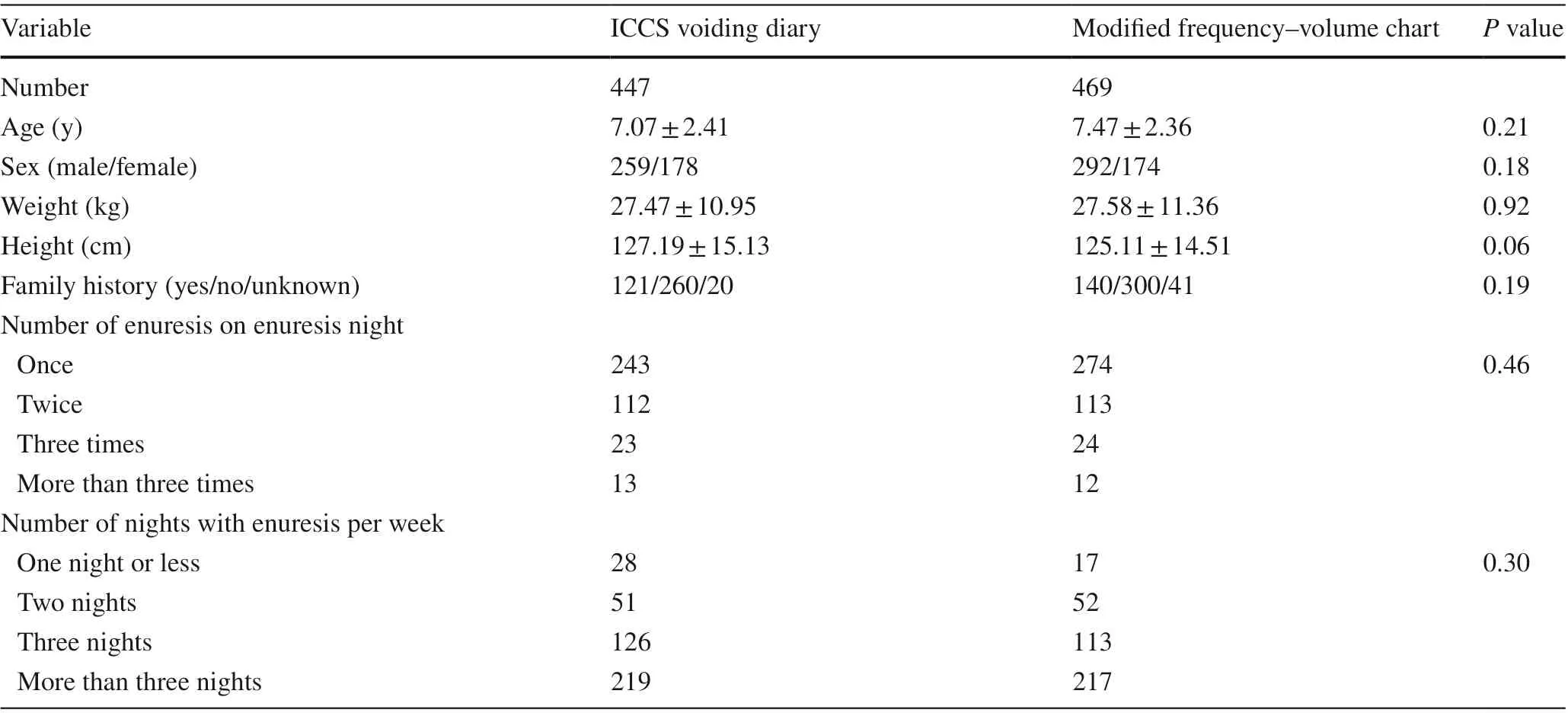
Table 1 Characteristics of the trial participants at baseline
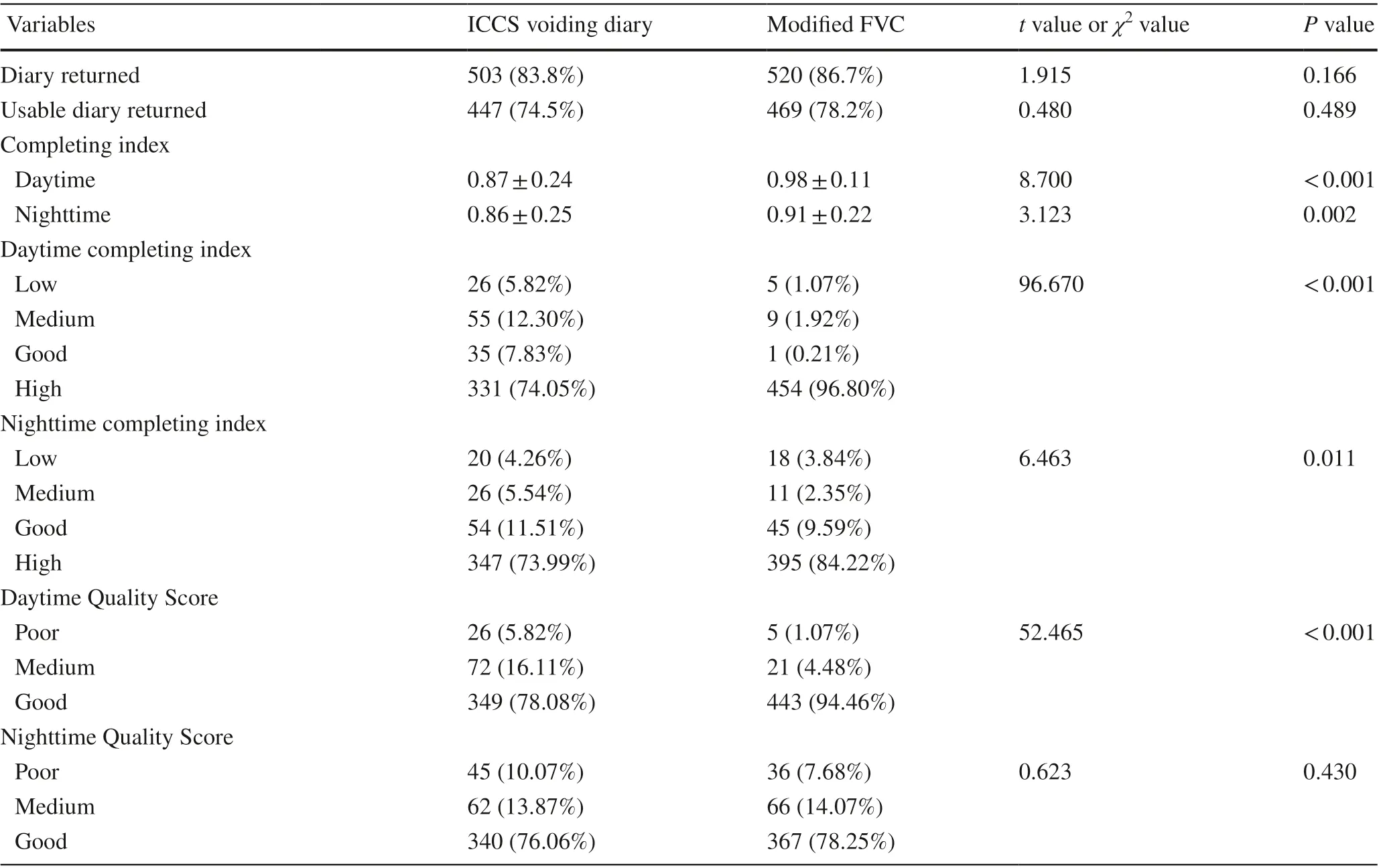
Table 2 Compliance for ICCS voiding diary and modified frequency-volume chart (FVC) data
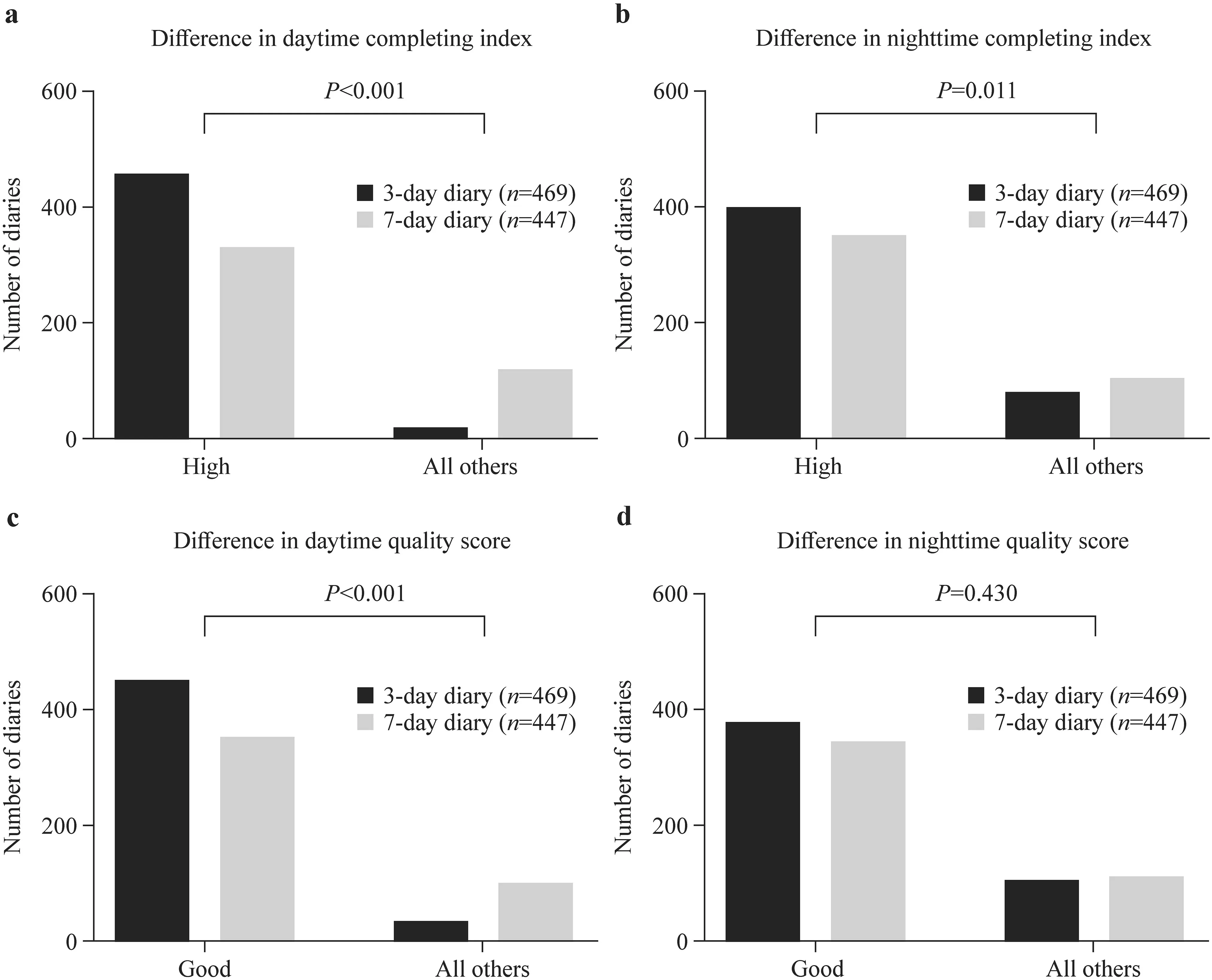
Fig. 2 Differences in compliance between patients who used frequency-volume chart (FVC) versus International Children’s Continence Society (ICCS) diaries. Daytime completing index ( P < 0.001),nighttime completing index ( P = 0.011), and daytime quality score( P < 0.001) differed significantly between patients that used FVC versus ICCS diaries. There was no significant difference in nighttime quality score ( P = 0.430) between patients that used FVC versus ICCS diaries.
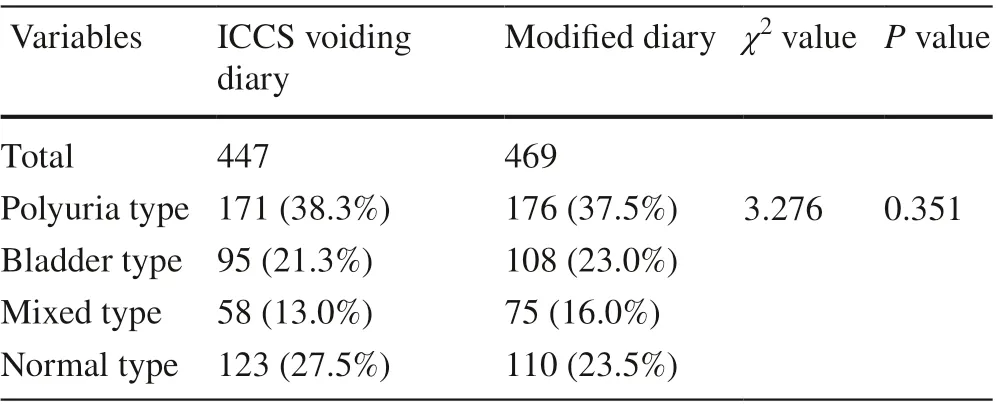
Table 3 The constituent of subtypes between two groups
Moreover, the present study was the first to evaluate whether the 3-day FVC was appropriate to PMNE children.Previous studies on compliance of voiding diaries were aimed at patients with urinary incontinence or lower urinary tract symptoms (LUTS), VD spanning different lengths of time have been evaluated, most commonly 24-72 hours but also up to 14 days [ 4, 12- 17]. Tincello et al. reported that by comparing the quality of data recorded in urinary diaries completed for 3 days compared with those completed for 7 days in adults with urinary incontinence, the 7-day diary included less complete data than the 3-day diary, even in the first 3 days of the longer diary [ 17]. This finding suggests that elements of diary “fatigue” and also diary “despair”may be acting. They suggest that a 3-day diary is superior in terms of data quality. Recently, the LURN study demonstrated that among 1064 participants with the symptoms of LUTS, 50% returned voiding diaries with perfectly complete data and an additional 39% yielded incomplete but usable data [ 15]. In addition, their results indicated that the 3-day VD is feasible and reliable for investigating patients with LUTS. Groutz et al. reported that compliance and data completeness improved from 76% in 3-day diaries to 92%in 24-hour diaries [ 13]. To improve VD completion rates and data quality, an electronic VD also was evaluated in the research setting in children with LUTS; however, the completion rates of electronic VD were somewhat lower compared to the paper VD [ 10]. More recently, a novel automated VD device was designed and was evaluated to record urine output measurements; however, the device's measurement error should be minimized and further studies with larger number of cases should be conducted [ 11].

Table 4 Comparison of micturition parameters between two groups with nocturnal polyuria

Table 5 Comparison of micturition parameters between two groups with small bladder subtype
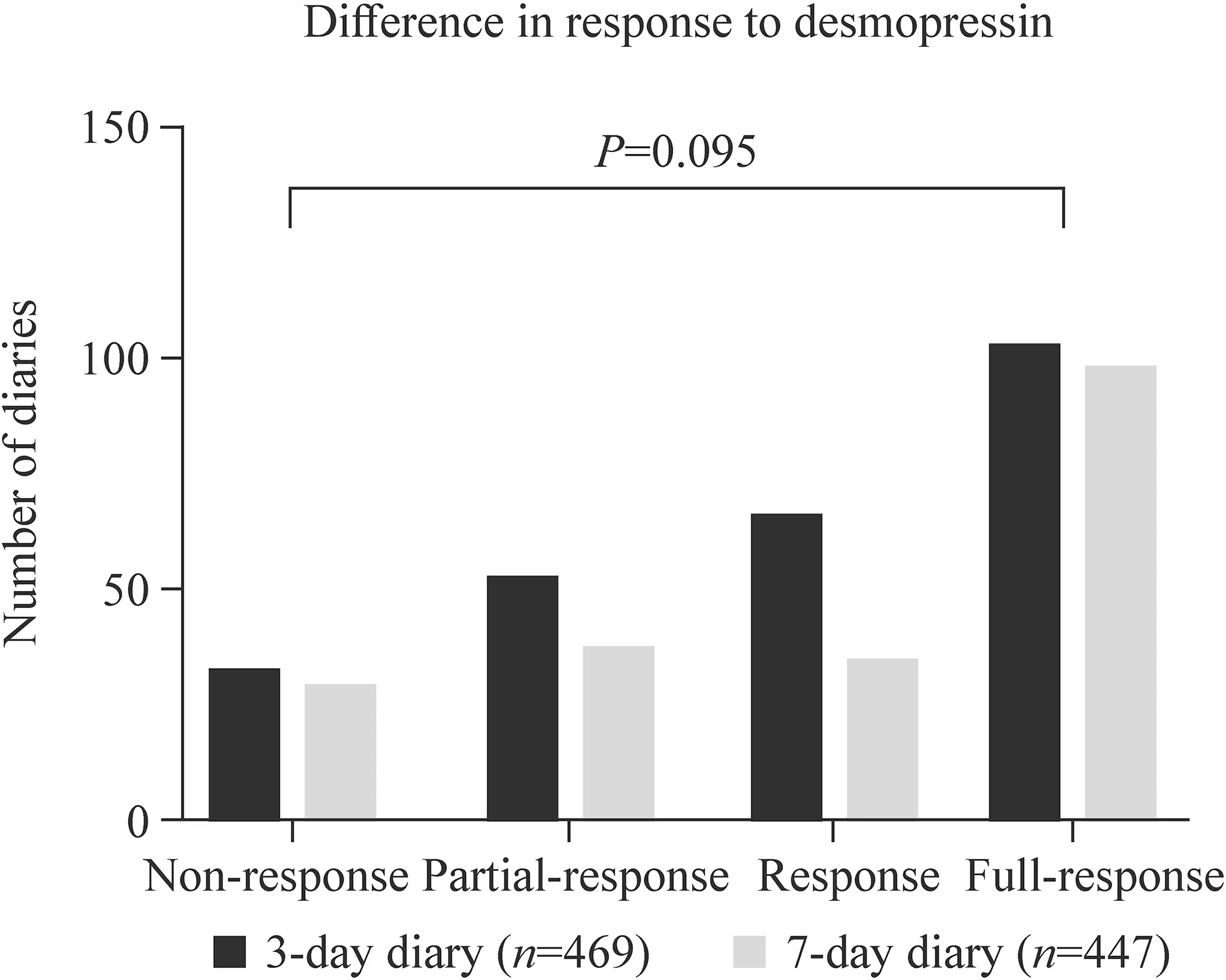
Fig. 3 Differences in response to desmopressin reported by patients that used FVC versus ICCS diaries. There was no significant difference in the response rate to desmopressin between two groups in children with nocturnal polyuria, mixed and normal subtypes ( P = 0.095).
Besides compliance, the validity of a VD is also very important. Rubilotta et al. compared voided volumes at FVC and at uroflowmetry in men with LUTS [ 18]. The data demonstrated a poor correlation between the voided volume recorded in 3-day FVC and those documented during uroflowmetry. This result supports common sense that the routine use of a VD is a first-step assessment tool. In 1988, Wymann et al. compared 1-week and 2-week FVC for a group of women suffering from incontinence. They concluded that the 1-week FVC was sufficient to document urinary frequency and incontinence episodes, and since then the 7-day FVC has been regarded as the gold standard [ 19].Lopes et al. conducted a voiding diary study over 3 days in 92 children with lower urinary tract symptoms [ 20]. They demonstrated that no differences were seen between 2-day and 3-day bladder diaries regarding fluid intake or maximum and average voided volume; however, using a 2-day diary, a small percentage of reduced bladder capacity diagnosis was lost. Elmer et al. showed that 24-hour diaries resulted in a statistically significant increase in invasive diagnostic tests and in other treatment recommendations compared to 3-day diaries [ 12]. This result implies that the 24-hour diaries were not as reliable as the 3-day diaries. Bright et al. also reported that the 3-day diary has been accepted as the standard bladder diary by International Consultation on Incontinence Questionnaire [ 21].
In the present study, all patients and their guardians tended to record the volume of every micturition during daytime, but only some recorded volume during nighttime because they preferred using a diaper during the nighttime.For this reason, the ratio of total voided volume/EBC could be calculated unambiguously, while the average voided volume/EBC could only be estimated at nighttime recording,which makes the nocturnal recording pattern not as clear and detailed as that of diurnal time. However, these do not affect the classification in children with enuresis, because the classification of enuresis is determined by the TVV and MVV [ 6], and the response rate to desmopressin of the two groups is similar, that also demonstrates that this modified FVC is available.
The present study has four strengths. One is its large sample size. As mentioned earlier, there are several studies concerning the best duration of the voiding diary, but none has such a large sample size. In our study, we enrolled 1200 patients from 13 different medical centers that were located in 10 different provinces in China. A second strength of our study is the source of samples. All patients recruited were unselected and untreated, and none of them had a history of family doctor visiting or therapy as there is no family doctor system in China. A third strength of our study is the time of recording: the FVC was recorded during a single weekend,which offers a more pleasant experience for children and a more convenient experience for their guardian because most of the participants are preliminary school or middle school students. The fourth advantage of their study is that patients were assigned to diary using randomization table.
We also acknowledge several weaknesses of the present study. First, we did not compare the validity and compliance of two diaries with same patients using different diaries at different times. However, it could be difficult to get the parental motivation to complete a second diary in a short time; second, the present results showed that there was a significant difference between groups in the nocturnal micturition frequency, so we suggest that the present modified FVC was more suitable to the newly diagnosed PMNE. For the patients with refractory NE, it would still be necessary to record their voiding diary for a longer time to provide more detailed information.
In conclusion, the modified FVC could be applied to obtain the voiding characteristics of children with PMNE as the ICCS-recommended voiding diary does and offers a reasonable and better choice for children with PMNE from the unselected population in the future.
Supplementary Information The online version contains supplementary material available at https:// doi. org/ 10. 1007/ s12519- 021- 00474-5.
Acknowledgements We thank all of the patients and their family members for participating in this study. We also thank Professor J. Vande Walle and Professor S. Rittig for their invaluable guidance in study design and execution. Professor Robert M. Dorazio did a lot for statistical analysis and result interpretation of the study.
Author contributions WJJ, WDJ, and FHD contributed equally to this paper. WJJ contributed to conceptualization, methodology, writingreviewing and editing, visualization; WDJ contributed to methodology,writing-original draft preparation, formal analysis, investigation, visualization; FHD contributed to conceptualization, methodology, writing-review and editing, supervision, project administration; MJH contributed to conceptualization, methodology, writing-review & editing,supervision, project administration; WDX contributed to resources,investigation; YQ contributed to resources, investigation; PXJ contributed to resources, investigation; FR contributed to resources, investigation; YHD contributed to resources, investigation; ZRF contributed to resources, investigation; WXW contributed to resources, investigation; LJW contributed to resources, investigation; ZF contributed to resources, investigation; CQX contributed to resources, investigation; LFF contributed to resources, investigation; CL contributed to: resources, investigation; ZJJ contributed to resources, investigation; LYJ contributed to resources, investigation; DY contributed to resources, investigation; HHM contributed to resources, investigation; BY contributed to resources, investigation; SXY contributed to resources, investigation; ZW contributed to resources, investigation; CGH contributed to resources, investigation; LCH contributed to resources, investigation; JYY contributed to resources, investigation; MML contributed to resources, investigation; JL contributed to resources, investigation; SQ contributed to resources, investigation;XH contributed to resources, investigation.
Funding This project received funding from the National Natural Foundation of China (81770710), Key Research and Development Plan of Zhejiang Province (2019C03028), the Major projects jointly constructed by the Zhejiang province and National Health Commission (WKJ-ZJ-1908), and the Natural Science Foundation of Zhejiang Province (LQ18H050001).
Data availability The datasets generated during and/or analyzed during the current study are available from the corresponding author on reasonable request.
Compliance with ethical standards
Conflict of interest No financial or non-financial benefits have been received or will be received from any party related directly or indirectly to the subject of this article. Author Jian-hua Mao is a member of the Editorial Board for World Journal of Pediatrics. The paper was handled by the other Editor and has undergone rigorous peer review process. Author Jian-hua Mao was not involved in the journal’s review of, or decision related to, this manuscript.
Ethical approval Ethical approval for this study was obtained from the Ethical Committee at the Children's Hospital of Zhejiang University School of Medicine (2017-IRB-011). Informed consent to participate in the study has been obtained from participants (or their parent or legal guardian in the case of children under 16).
杂志排行
World Journal of Pediatrics的其它文章
- Muscle strength and its association with cardiometabolic variables in adolescents: does the expression of muscle strength values matter?
- Challenges and suggestions for precise diagnosis and treatment of Wilson’s disease
- Vestibular function of pediatric patients with sudden sensorineural hearing loss: based on vertigo symptom and vestibular function testing
- Consensus statement on the epidemiology, diagnosis, prevention,and management of cow's milk protein allergy in the Middle East:a modified Delphi-based study
- Treatment of pediatric mild persistent asthma with low-dose budesonide inhalation suspension vs. montelukast in China
- Haploidentical hematopoietic stem cell transplantation for pediatric patients with chronic active Epstein-Barr virus infection:a retrospective analysis of a single center
